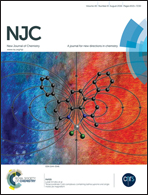Interplay between hydrophobicity and basicity toward the catalytic activity of isoreticular MOF organocatalysts†
Abstract
Due to the structural diversity of metal–organic frameworks, MOFs, tailored engineering of these compounds is important for their use in catalytic processes. Among the MOFs tested as heterogeneous catalysts, there have been rare reports of size selective catalysts. In the present work, we could successfully indicate that subtle substrate selectivity can be induced in the catalytic system by designing a series of isoreticular MOFs with slight structural modifications. Four MOF catalysts possessing imine and/or amine basic N-donor pillars bearing phenyl or naphtyl cores showing different hydrophobic characters around the basic reaction center were prepared via a simple mechano-chemical synthesis. They were characterized thoroughly using TG, IR and PXRD analysis. For the first time, the aldol-type condensation reaction of malononitrile with ketone-functionalized carbonyl substrates was developed in the presence of the basic MOF organocatalysts. Moreover, it has been successfully shown that a subtle substrate selectivity can be addressed during the reaction of three slightly different α,β-unsaturated carbonyl compounds in contrast to the effect of size control barriers that commonly direct a heterogeneous reaction pathway.


 Please wait while we load your content...
Please wait while we load your content...